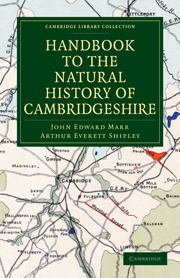Book contents
- Frontmatter
- PREFACE
- Contents
- ADDENDA AND CORRIGENDA
- PHYSIOGRAPHY
- GEOLOGY
- VERTEBRATE PALÆONTOLOGY
- ZOOLOGY
- Mammals
- Birds
- Reptiles and Amphibians
- Fishes
- Mollusca
- Insects: Introduction
- Insects: Orthoptera
- Insects: Neuroptera
- Insects: Hemiptera
- Insects: Coleoptera
- Insects: Lepidoptera
- Insects: Diptera
- Insects: Hymenoptera
- Myriapoda
- Arachnida
- Crustacea
- FLORA
- PREHISTORIC ARCHÆOLOGY
- Appendix to the Article on the Mollusca
- INDEX
- Plate section
Insects: Introduction
Published online by Cambridge University Press: 10 November 2010
- Frontmatter
- PREFACE
- Contents
- ADDENDA AND CORRIGENDA
- PHYSIOGRAPHY
- GEOLOGY
- VERTEBRATE PALÆONTOLOGY
- ZOOLOGY
- Mammals
- Birds
- Reptiles and Amphibians
- Fishes
- Mollusca
- Insects: Introduction
- Insects: Orthoptera
- Insects: Neuroptera
- Insects: Hemiptera
- Insects: Coleoptera
- Insects: Lepidoptera
- Insects: Diptera
- Insects: Hymenoptera
- Myriapoda
- Arachnida
- Crustacea
- FLORA
- PREHISTORIC ARCHÆOLOGY
- Appendix to the Article on the Mollusca
- INDEX
- Plate section
Summary
Cambridgeshire, although small, possesses a remarkably rich and varied Entomological fauna, due to a considerable variety of country being included in the long straggling shape of the county.
Of real fen-land very little remains; the whole of the northern part of the county, the centre of that large tract of Fens which extends into north Huntingdonshire, Lincolnshire, Norfolk and Suffolk, has been reclaimed, and is now, with the exception of small isolated parts, agricultural land of a somewhat uninteresting character, at least from the entomologist's point of view. The Fens of Horningsea, Bottisham, Swaffham, and Burwell, immediately north of Cambridge, have also been reclaimed in the last thirty or forty years, and although a semi-wild state is maintained in parts where turf-digging is carried on, the greater part is cultivated land, and but few of the interesting insects which were to be found there in the middle of last century remain. About 300 acres of sedge fen at Wicken alone survives in something of its original state; a succession of bad hay seasons has however raised the value of sedge and such rough fodder as the Fen produces, and a considerable amount of cutting has been done, to facilitate which a lot of bushes have been “stubbed” up.
- Type
- Chapter
- Information
- Handbook to the Natural History of Cambridgeshire , pp. 139 - 141Publisher: Cambridge University PressPrint publication year: 2010First published in: 1904

